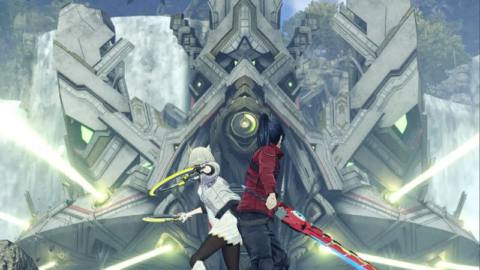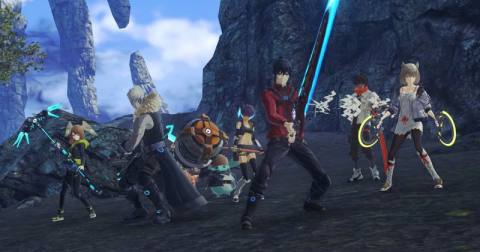
Reviewed on: Switch
Platform: Switch
Publisher: Nintendo
Developer: Monolith Soft
Release:
Monolith Soft has struggled to recreate and magnify the novelties of the first Xenoblade Chronicles adventure since its 2012 release. The third chapter in the science-fantasy JRPG series suffers the same frustrating fate as XC X and XC 2. Despite its first-rate combat and character progression features, Xenoblade Chronicles 3 is a bloated trek across vast but lifeless environments further diminished by an unaffecting narrative with one of the worst ensemble casts in the franchise.
XC 3 employs a real-time battle system where “Arts,” advanced skills mapped to the controller’s face buttons, give fights a natural, straightforward cadence. By canceling auto-attacks into Arts while balancing cooldown timers, I made quick work of most early-game enemies. However, seeking stronger challengers defending rare treasures or simply grazing off the beaten path forced me to reconsider conventional attack patterns and interact with every mechanic. From taking control of a healer and issuing a “group up” tactic so I could save my team with wide-reaching AoE Arts to toppling staggered enemies with combos, every decision I made felt valuable and rewarding.
Classes add more excitement to the loop. The six playable party members can learn any class, encouraging me to experiment with combinations. Even seventh “hero” characters, recruited from main and side quests, offer rarer, hybrid classes to choose from. Some of my fighters touted robust health and defensive stats, making them shoo-ins for tank classes, while the dexterous were better suited for DPS roles. Each class came equipped with its own set of Arts/passive skills and was a joy to play. I liked drawing aggression with heavy guard taunts and then switching to a dual-sword attacker to pierce the preoccupied foe in the back. Healing the squad moments before a devastating strike made mid- to late-game engagements invigorating.
My favorite combat features were Interlinks and Chain Attacks. Both are activatable after filling gauges by performing class abilities, with the former allowing two party members to fuse into a humanoid robot called Ouroboros. These gargantuan deities eliminate swaths of opponents in one fell swoop or even the odds with mighty bosses. Chain Attacks are team-wide specials that dramatically slow the action, allowing a sequence of character Arts to not only dole out severe damage but also enable bonuses like reduced aggression and high evasion. Interlinks and Chain Attacks were power trips that always made me smile, even when my patience with the plot and exploration wore thin.
The Keves and Agnus nations are locked in perpetual conflict, with both sides suffering tremendous losses. Soldiers are subject to morbid, bloody 10-year lifespans. So, when Noah, Eunie, and Lanz join forces with Agnus operatives Mio, Taion, and Sena, the crew settles on new goals: end the intercultural violence, defeat the “true” enemy, and find a righteous reason to live. This premise is eerily similar to last year’s Tales of Arise. Where infectious, likable personalities remedied that game’s occasional thematic blunders, XC 3’s protagonists are forgettable caricatures that lack the emotional complexity a story of this nature requires. Stiff cutscene animations coupled with mind-numbingly repetitive barks – “I’m the MVP!” or “That’s a rare doodad!” – do the six champions no favors.
This superficiality extends to the explorable backdrops, which lack the awe-inspiring points of interest and vistas from previous Xeno entries. These open-world zones are chockful of dangerous creatures, from flying stingrays to ferocious, kaiju-sized apes and collectible items which can be sold for a profit or submitted to fetch quest NPCs. Beyond challenging monsters, collecting respawnable drops, and recruiting heroes at Keves or Agnus settlements, there’s not much to do or see. The generic locales – forests, deserts, mountains; you can probably guess the rest – were barren spaces I’d navigate for hours to arrive at the next underwhelming story checkpoint.
Thankfully, character progression systems helped alleviate the monotony. XC 3 offered an impressive number of ways to amplify the strength of my party. At camps scattered throughout each biome, I’d level everyone up, craft gemstones that increase specific stats, and cook meals that affect XP and CP (Class Point) gains. There’s even an Interlink skill tree that let me augment the combat prowess of my Ouroboros. Smaller-scale upgrades, like improved running speed or meal effect duration, came from completing fetch quests, speaking with NPCs, and freeing Keves or Agnus settlements – this usually amounted to working alongside a hero to beat a powerful adversary. The customization depth made gameplay more enjoyable, but after dozens of hours doing the same activities to bolster my combat efficiency, the sheen wore off.
My party of seven felt like a little army when explosive Arts and flashy Ouroboros combos lit up an already-chaotic battlefield. And the quality-of-life improvements like customizable shortcut hotbars and in-game GPS streamlined menu-surfing and traversal. Still, the narrative and world designs left much to be desired as critical plot twists are frustratingly obvious, character growth is virtually nonexistent, and navigation in each uninspired environment proves to be a tiring exercise. Xenoblade Chronicles 3 is a double-edged sword that needs a bit more sharpening.
Score: 7.25
About Game Informer’s review system






